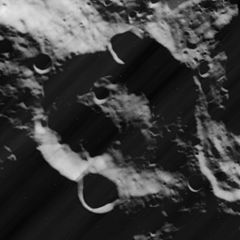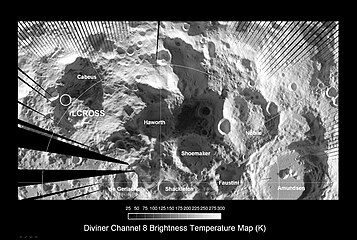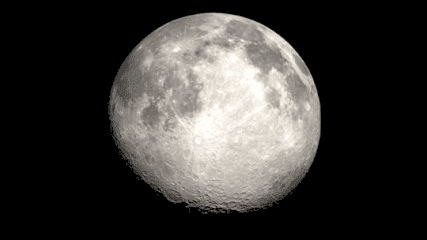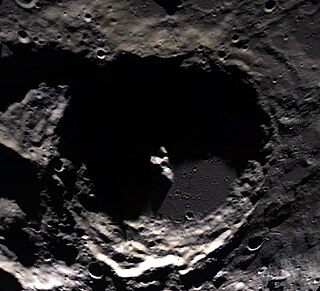
Amundsen is a large lunar impact crater located near the south pole of the Moon, named after the Norwegian explorer Roald Amundsen. It lies along the southern lunar limb, and so is viewed from the side by an observer on the Earth. To the northwest is the crater Scott, a formation of similar dimensions that is named for another Antarctic explorer. Nobile is attached to the western rim.

Scott is a lunar impact crater near the south pole of the Moon. Its location close to the lunar limb hinders observation, both from the foreshortening of the crater as seen from Earth and from the limited sunlight that enters the basin. The northern end of this crater is in near perpetual darkness, and has not been mapped in detail. Scott lies between the similar-sized crater Amundsen to the southeast and Schomberger to the northwest. Just to the northeast is the crater Demonax.

Fabry is a large lunar impact crater of the form termed a walled plain. It is located on the far side of the Moon, just beyond the northeastern limb. Parts of this area are sometimes brought into view by the effects of libration, but the terrain is seen from the edge and so not much in the way of detail can be observed.

de Gerlache is a lunar impact crater that is located along the southern limb of the Moon, within a crater diameter of Shackleton at the south pole. From the Earth this crater is seen from the edge, and it lies in perpetual darkness. Thus little or no detail can be seen of this crater, other than the edge of the rim. However, the crater is clearly visible in Earth-based radar images. The crater is roughly circular, with some slight wear. No craters of note overlie the rim, although some formations may be attached to the southern and western edges.

Black is a small lunar impact crater that lies just to the southeast of the walled basin Kästner. To the south-southwest is the crater Ansgarius, and to the east is the small Dale. It is located near the eastern limb of the Moon, just to the southwest of the Mare Smythii.

Damoiseau is a lunar impact crater that is located just to the west of the Oceanus Procellarum, in the western part of the Moon's near side. It lies due east of the prominent crater Grimaldi, a walled plain with a distinctive dark floor. Due south of Damoiseau is the crater Sirsalis.

Cori is a lunar impact crater that is located in the southern hemisphere on the far side of the Moon. It lies less than one crater diameter to the north of the crater Baldet. To the northeast is the crater Grissom. It is named after Gerty Cori, the first American woman to win the Nobel Prize and the first woman to win the prize in the category Nobel Prize in Physiology or Medicine.

Celsius is a small lunar impact crater that is located in the rugged terrain in the southern hemisphere on the Moon's near side. It is named after Swedish astronomer, physicist and mathematician Anders Celsius. It lies less than one crater diameter to the south-southwest of the crater Zagut, and due north of Büsching.

Planck is a large lunar impact crater, approximately 319 kilometers in diameter, that is located in the southern hemisphere of the Moon, on the far side as seen from the Earth. It lies to the west of the walled plain Poincaré, another enormous formation only slightly larger than Planck. Lying across the southeast rim of Planck is the crater Prandtl, to the northeast is Hildegard, and to the west is Fechner. Planck is located within the South Pole–Aitken basin.

Coriolis is a lunar impact crater that is located on the far side of the Moon. The crater floor is bisected by the lunar equator, and it lies about three crater diameters northwest of the crater Daedalus.

Faustini is a lunar impact crater that lies near the south pole of the Moon. It is located nearly due south of the much larger crater Amundsen, and is almost attached to Shoemaker to the southwest. About one crater diameter due south is the smaller crater Shackleton at the south pole. A small crater is attached to the eastern rim of Faustini.

Hédervári is a lunar impact crater that is located in the southern part of the Moon, only a few crater diameters from the south lunar pole. It is attached to the northern rim of the larger crater Amundsen, and lies south of Hale. Due to its location, this crater is viewed nearly from the edge from Earth, which hinders the amount of detail that can be observed. It is also illuminated obliquely by the Sun, and the interior is often cloaked in shadows.

D'Arsonval is a small lunar impact crater on the far side of the Moon. It is situated across the northeastern rim of the older and larger crater Danjon. To the west of D'Arsonval is Perepelkin.
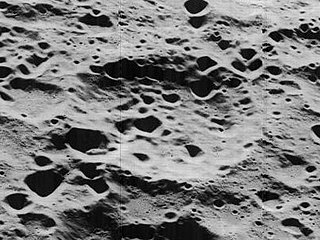
Dunér is an old lunar impact crater that is located in the northern hemisphere on the far side of the Moon. It lies to the southeast of the crater Chernyshev, and west-southwest of the Perkin–Debye crater pair.

Fleming is a large lunar impact crater that is located on the Moon's far side, and cannot be seen from the Earth. It lies about a crater diameter to the east-northeast of Hertz, and to the northwest of Lobachevskiy.

Quetelet is a lunar impact crater, approximately 55 kilometers in diameter, that lies in the Moon's northern hemisphere, on the far side from the Earth. It lies to the southeast of the crater Schlesinger, and to the east of Von Zeipel. To the east of Quetelet is Perrine.

Harriot is a lunar impact crater that is located on the far side of the Moon from the Earth. It lies just to the north of the much larger crater Seyfert. To the northeast of Harriot is the crater Cantor. About one and a half crater diameters to the north of Harriot is the eastern end of a crater chain named Catena Sumner. This feature continues to the west-northwest for a distance of 247 km, passing to the north of the crater Sumner.

Vening Meinesz is a lunar impact crater on the far side of the Moon. The northern inner wall of this crater lies along the lunar equator. To the north of this formation is the larger crater Mandel'shtam, and slightly farther to the south is the larger Keeler. Dewar is located less than one crater diameter to the southeast of Vening Meinesz.

Möbius is a lunar impact crater that is located on the Moon's far side, beyond the eastern limb and northeast of the Mare Marginis. It lies less than one crater diameter to the northwest of the larger, 90-km-diameter Hertz, and just to the southeast of Popov. To the north of Mobius is the crater chain designated Catena Dziewulski, which takes its name from the crater Dziewulski to the north-northwest.
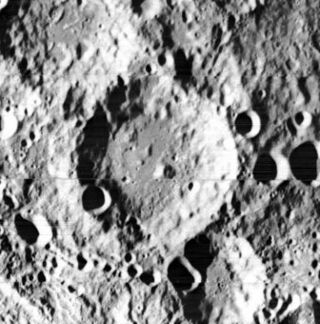
Stratton is a lunar impact crater on the Moon's far side. It is located to the north of the large craters Keeler and Heaviside, and less than one crater diameter to the south of Dewar.

